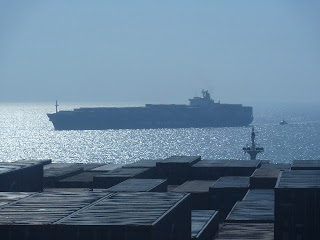

0800 and we're passing through the Bab-el-Mandeb - the ‘Gate of Grief’ or ‘Gate of Tears’ - from the Red Sea into the Gulf of Aden. Unstable Yemen to port and Djibouti and Somaliland to starboard; anarchic Somalia ahead, also to starboard. Amber is at more than twenty knots.
This narrow waterway presents as good a chance as anywhere of pirate attack with automatic weapons and rifle propelled grenades. On the chart table is the latest report of hijacked vessels potentially used as pirate 'motherships'. Some are surprisingly large.

Last year, Captain 'Boni' watched skiffs launching from a nearby vessel; he made off at high speed and the skiffs headed elsewhere. He says how upsetting it is to hear a frantic radio "Mayday! Mayday! Pirates boarding!" and be unable to do anything.
According to the U.S. State Department, in 2010 Somali pirates captured over a thousand sailors aboard forty-nine vessels. As of mid-2011, four hundred seafarers were hostages and eighteen hijacked ships being held for ransom.
Anxious lookout as we near a ship similar to ones in the report.
If not using motherships, these maritime criminals operate from the many barren islands along the coast.
0815. Third Mate Elijun Tan intently studies three radar screens set for different distances. The cadet tracks an object to starboard. It's a motorboat moving quickly.
At a near run, the captain returns to the bridge. One of the watchmen hurries to the wheel as the captain takes us off autopilot, ready for quick maneuvering. An uneasy few minutes; some quiet, calm commands and eventually the motorboat heads in another direction.
Our speed and very high freeboard may have dissuaded the pirates - if they were pirates - from visiting. CMA CGM says there already have been more than ten pirate attacks on its ships this year.
The captain turns to me and - trying to ease the tension - points out an "interesting" bird in front of the wheelhouse. "I wonder what that is?" he says. Everyone relaxes a little, just a little.
Here's our situation at 0902. We've reduced speed slightly and are headed for an 'Internationally Recommended Transit Corridor' to follow along the Gulf and into the Arabian Sea. On the radio, I can hear another vessel contacting a British warship in the area.
Now the day's important news: the captain insists I must use his chair when on the bridge. Below are 'my' temporary chair and view. As I peer through my Mountain Equipment Co-op binoculars, the third mate smiles: "Helping with the lookout, huh?" You betcha.



















































